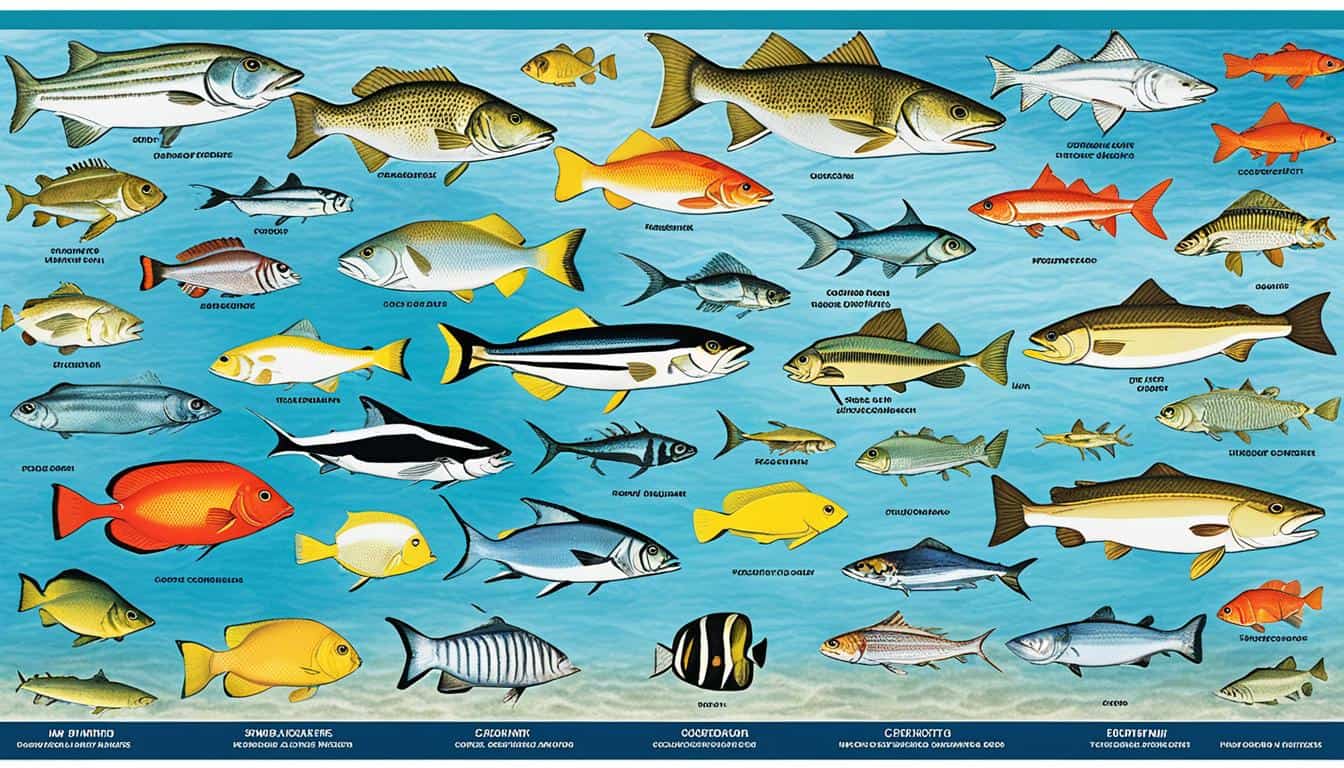Identifying fish species in the USA is both fun and challenging. With over 35,000 kinds of fish, it’s quite a task. Learning the right tools and methods helps you spot different fish. This skill is helpful for anglers, nature lovers, and fish experts. Knowing how to identify fish lets you enjoy and learn from America’s water creatures.
Using Technology for Fish Identification
In today’s world, technology is key for identifying fish. With the right tools, you can easily tell one fish from another in the USA.
Smartphone Apps and Databases
Apps like iNaturalist and FishVerify are changing how we identify fish. They use AI and images to tell you what fish you’re looking at quickly. This makes learning about fish in the U.S. fun and easy, no matter your skill level.
Government Resources
State Departments of Natural Resources (DNR) offer lots of help with fish identification. They have detailed guides and lists of local fish species. These online tools help you identify fish in the U.S. accurately.
Online Communities and Forums
Platforms like Fishbase and Reddit’s r/Fishing are great for talking with other fish lovers. Here, you can share pictures and get tips from experts to improve your fish-spotting skills.
Using these new tech resources, you’ll get better at knowing U.S. fish types. It makes exploring ichthyology more fun!
Understanding Fish Anatomy
Learning about fish anatomy is key for identifying them. Knowing their body shape, fins, and colors helps a lot. You need these to use a fish identification key well.
Body Shape and Size
How a fish looks and how big it is are very important. They can be long like an eel or round. Big fish look different from small ones. Knowing this helps a lot in identifying fish.
Fin Arrangement
Fins are also critical for ID. Fish have different fins like dorsal, pectoral, and caudal. Fins’ shapes and positions give important clues too.
Coloration and Patterns
Colors and patterns can identify a fish. They change with age and can be different in males and females. Knowing this helps spot fish types.
| Feature | Description | Example Species |
|---|---|---|
| Body Shape and Size | Varied shapes from elongated to round, range in size | Largemouth Bass, White Bass |
| Fin Arrangement | Position, number, and type of fins differ | Bluegill, Catfish |
| Coloration and Patterns | Stripes, spots, and color variations | Rainbow Trout, Clownfish |
Understanding fish anatomy helps you identify them easily. It also makes you appreciate their beauty and diversity. Using these tips makes fish ID fun and rewarding.
Koaw’s Mnemonic for Fish Identification: BAMFAD
The BAMFAD helps you remember how to spot different fish. It was created to make finding fish species easier. This way, by checking key details, you can get better at telling fish apart.
Body
First, note the fish’s shape and size. This step helps tell if a fish is long or shorter by appearance.
Appearance
Second, look for colors and patterns on the fish. These marks are like clues in a puzzle to identify it correctly.
Mouth
Next, look closely at its mouth. The way a fish’s mouth is can tell you which type it is, a crucial part of BAMFAD.
Fins
Then, check out its fins. The fin setup is key in the BAMFAD way. It helps recognize different fish kinds.
Area
Think about where the fish lives. This is very important in the BAMFAD method. It helps you figure out the fish species based on its usual places.
Demeanor
Last, watch how the fish behaves. The way a fish moves and acts is another clue to its identity, completing the BAMFAD process.
Utilizing Local Guidebooks
Fish identification guidebooks are a must when trying to name different fish. They are made by experts and full of pictures and facts. This helps you tell one kind of fish from another.
Guidebooks don’t need power or the internet to work. So, you can use them anywhere, even when gadgets die. They also talk about the local environment, which makes learning more interesting. Plus, turning the pages of a real book is a nice way to explore the fish near you.
A book about fish is super handy for anyone into fishing or nature. It doesn’t matter if you know a lot or a little. You’ll get a lot from reading these books. Let’s see why books might be better than online info:
| Features | Local Guidebooks | Digital Resources |
|---|---|---|
| Accessibility | Always available | Dependent on battery/internet |
| Detail Level | High, with extensive visuals | Variable, depending on source |
| Comprehensiveness | Includes ecosystem insights | Focused mainly on identification |
| User Experience | Tactile and engaging | Interactive but often impersonal |
Using both books and online helps you know fish better. Together, they offer a full view of American fish.
How to Identify Different Species of Fish in the USA?
To tell fish apart in the USA’s waters, you need to know about both fresh and saltwater homes. This understanding is key when trying to figure out what kind of fish you see.
Freshwater Fish Species
Lakes, rivers, and streams are where you find fish like Largemouth and White Bass. To ID these, you look at where they live, how they look, and what they do.
- Habitat: Different types of freshwater are home to various fish.
- Physical Characteristics: Shapes, fins, and colors can tell species apart.
- Behavior: Watching how they act when breeding or feeding also helps.
Saltwater Fish Species
“Salties” live in oceans and coasts, creating a different world. To spot fish here, you need a saltwater fish species guide. Striped Bass are just one example.
- Habitat: These fish love saltwater and live in various ocean areas.
- Physical Characteristics: You notice special features like scales and fins in these species.
- Behavior: Look out for how they move and eat. This can tell you a lot.
Knowing the contrast and identifying American fish species both in fresh and saltwater is important. Every place has its own fish, calling for sharp and informed fans to learn all about each world.
Studying Habitat and Behavior
Finding out where fish live and watching how they act helps us tell them apart. We can learn a lot by seeing where fish like to live. For example, some fish prefer rocky places, while others like deep water. Fish show us they belong to certain places by how they look and act.
Noticing how fish act, like if they swim in groups or alone, helps us identify them. Some fish, for instance, like to swim together in schools. Seeing these actions gives us big hints about what kind of fish they are.
| Habitat Type | Fish Species | Behavior |
|---|---|---|
| Rocky Areas | Smallmouth Bass | Feeding near rocks and hiding in crevices |
| Aquatic Vegetation | Northern Pike | Ambush predator, hiding in vegetation |
| Deep Water | Lake Trout | Slow movement and feeding at depth |
Seeing how fish and their homes fit together is key to knowing them. When we understand what fish look like, where they live, and how they act, we get to know them better. This broad approach helps us appreciate all the different fish in a deeper way.
Fish Identification Tips for Beginners
Starting to learn about fish? Here are some key tips to make it easier. Learn to spot differences like body shape, fin setup, and colors. This makes telling different fish apart less confusing.
First, know your local fish well. This helps you identify fish you see often and those that are new to you. Begin with fish species you often come across.
Being patient and practicing regularly are crucial. Noticing the small differences between species helps a lot. Also, using tools like field guides and apps can be very helpful in identifying fish.
“The key to successful fish identification is a combination of keen observation, reference resources, and steady practice.” – Expert Angler
Follow these fish identification tips to get better at identifying fish. It will help you enjoy fish and their habitats more. At first, learning may feel hard, but with practice and the right tools, you’ll get better.
- Focus on body shape.
- Note the fin configuration.
- Observe color patterns attentively.
- Refer to local species for a foundational base.
- Utilize technology like apps and guidebooks.
Starting with these basics makes learning about fish more fun and easier. With practice, you’ll soon be able to spot different species without trouble.
Importance of Accurate Fish Identification
Knowing fish types is key for staying within fishing laws and helping the environment. It ensures we follow the legal fishing regulations. This helps preserve the balance of sea life and their habitats.
Legal Implications
Obeying legal fishing regulations is critical to keep fish numbers steady. Laws like catch size and number limits protect fish from overfishing. They also guard against damaging the habitat. It’s also important to know which fish are endangered. This way, we can fish responsibly and avoid penalties.
Conservation Efforts
Getting fish identification right stands at the heart of saving these creatures. It aids monitoring and planning to protect different species. By keeping aquatic ecosystems healthy, we ensure there are plenty of fish for the future. This effort matters a lot, whether you fish for fun or care for nature.
Recognizing Common Fish in U.S. Waters
Learning about common U.S. freshwater and saltwater fish helps you identify different species. It makes it easier to spot these fish in American waters. This knowledge boosts your identification skills when fishing.

Popular Freshwater Species
In rivers and lakes, you often see certain fish. Bass, for example, are very common. You will find:
- Largemouth Bass – It has a big mouth, even bigger than its eyes.
- Shoal Bass – Lives in fast-moving waters.
- Redeye Bass – Has a red eye and likes clear streams.
Knowing these fish makes your fishing trips better.
Common Saltwater Species
At the coast, other fish types are more common. Learning about U.S. saltwater fish adds to your knowledge. You should recognize:
- Striped Bass – Has stripes all along its body.
- White Bass – Its color is silver, and it moves in groups.
Identifying these fish helps you have a better time fishing. It doesn’t matter if you’re in freshwater or at the beach.
Common Variations Among Fish Species
Knowing the common differences among fish is important for anglers, naturalists, and fish scientists. These differences come from many places like how old they are, if they’re male or female, or their family traits. It’s key to being able to tell fish apart correctly. This makes diving into these details essential.
Changes in appearance because of age are easy to see in fish. Young fish often look very different than older ones. Take the Largemouth Bass for example. A young one might have different patterns and colors than an older fish. These changes show us how fish grow, but they can also make identifying them more challenging and interesting.
Male and female fish can look really different too. This is called sexual dimorphism. Sometimes, one gender is bigger, has different colors, or unique fin shapes. Betta fish are a good example. Betta males are bright with pretty fins while females are simpler looking. Knowing about these differences helps in identifying fish better.
Even within the same species, individual fish can look different. This is because of things like where they live and their genes. Noticing these slight variations can improve your fish knowledge. It makes identifying fish a richer experience. Learning about these variations makes us closer to the fish world.
FAQ
How do you identify different species of fish in the USA?
To identify fish, it’s important to look at their body shape, fins, color, and patterns. Use tools like apps and online resources. Also, check guidebooks and learn about the fish’s behavior.
How can technology help in fish identification?
Technology offers apps like iNaturalist and FishVerify. These apps use AI to recognize fish from pictures. There are also online communities and government sites that share a lot of information.
What anatomical features are important for identifying fish species?
For identification, notice the fish’s body shape, fin types, and colors. These features help to tell one fish species from another.
What is BAMFAD and how does it simplify fish identification?
BAMFAD is a tool that stands for Body, Appearance, Mouth, Fins, Area, Demeanor. It helps people remember what to look for in a fish to identify it. Each letter reminds us of certain important features.
Why are local guidebooks valuable for fish identification?
Local guidebooks have helpful pictures and details not always found online. They’re written by fish experts and are great for learning about local fish, especially in rural areas.
What are the key differences between freshwater and saltwater fish identification?
Freshwater fish live in lakes and rivers, while saltwater fish are in the ocean. Knowing this can make it easier to figure out what type of fish you’re looking at.
How does studying habitat and behavior assist in fish identification?
Looking at where fish live and how they act can give big hints. It helps to know that certain types of fish prefer different kinds of places and do certain things.
What tips can help beginners in fish identification?
Beginners should focus on simple features like body shape, fins, and colors. Start with local fish you see often. Learning with patience and practice will help you get better.
Why is accurate fish identification important?
Getting fish identification right is important for the environment and following rules. It helps protect the right kinds of fish and keeps water ecosystems healthy.
What are some common fish species found in U.S. waters?
In the U.S., you’ll find freshwater Bass like Largemouth and Shoal Bass. In saltwater, there are Striped Bass and White Bass. Knowing these well-known fish helps with spotting them.
What are common variations to look out for in fish species?
Fish can look different based on their age, gender, and genes. Adults, babies, and males and females may have different looks. Being able to spot these differences is key to identifying fish accurately.







